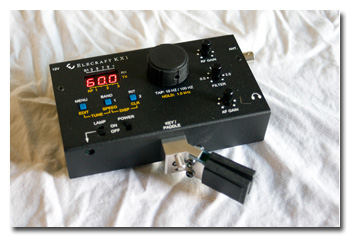by William Eric McFadden
Note: I no longer own an Elecraft KX1, having sold it in September, 2013 to help fund the
purchase of an Elecraft KX3. This page about the KX1 will remain
active for archival purposes.
I now realize I made a mistake in selling my KX1 and am looking for another.
From the manual (revision E, May 21, 2010):
-
The Elecraft KX1 is a compact, multi-band CW transceiver optimized for backpacking and travel use. With internal battery, internal automatic antenna tuner, log-book lamp, and plug-in keyer paddle, it offers a high level of integration.
Unlike most transceivers, the KX1's controls are located on the top of the cabinet, and the keyer paddle attaches at the front. This "trail-friendly" format is ideal for hand-held or lap-top operation, e.g. when sitting on the ground, using a camp chair, reclining, or even standing. The KX1 is also at home on a table or desk, providing an optimal display viewing angle without the need for a tilt stand. The unique plug-in keyer paddle is both physically reversible for right- or left-handed use.
The transceiver covers the full 40 and 20 meter bands, and optionally 80 and 30 meters. The VFO is based on a DDS (direct digital synthesis) IC, so it can also tune well outside each band, covering many popular SWL band segments. A variable bandwidth crystal filter permits reception of SSB and AM as well as CW, facilitating cross-mode contacts and broadcast reception.
The KX1's internal six-cell battery pack can be changed in seconds with the removal of two thumb screws. The battery provides 1 to 2 watts power output, which represents a good tradeoff between battery life and communications efficiency. An external 12 V supply increases output to about 4 watts. Low receive-mode current drain (35 mA typ.) results in battery life of 20 hours or more. The low-battery warning threshold can be adjusted to match the battery type used.
The KX1 uses a 3-digit LED display that is physically rugged and extremely efficient. It requires just 1 to 2 milliamps total current in moderate lighting conditions, and about 10 mA at its brightest setting. The operator can optionally configure the display to turn off 5 to 60 seconds after any front-panel control has been used. Operation without the display is possible if the CW feedback feature is turned on (audio Morse code). This provides audible announcement for the VFO dial, menu text, and all controls.
Additional operating features include instant band selection, nine frequency memories, three VFO tuning rates, receive incremental tuning (RIT), USB/LSB receive on all bands, and an S-meter display mode. The built-in keyer offers Iambic modes A and B and two message buffers. In an emergency, two of the front panel switches can be configured for use as a manual key or keyer paddle.
Despite its compact size and many built-in accessories, the KX1 is easy to build. The basic unit consists of a single printed circuit board, with no surface mount components to install (the three surface mount parts used are pre-installed). Assembly and test are completed in phases to simplify any needed troubleshooting, and only a few alignment steps are required.
My KX1, serial number 1100, has firmware revision 1.02 and the KXB3080 30m/80m and KXAT1 Internal Automatic Antenna Tuner options. I bought the KXPD1 Keyer Paddle with my KX1 but, sadly, had no success in using this nicely-engineered paddle, and subsequently sold it.
I bought my transceiver used and can't comment on the building of a KX1. My KX1 was beautifully built by Drew McDaniel, W8MHV; it is the second of three KX1s Drew has built.
My KX1 is the heart of my KX1 Mini Travel Kit.
Manuals:
- (Check Elecraft for latest versions of the manual and errata.)
- KX1 Manual Rev. E (2.7MB PDF)
- KX1 Quick Reference Guide (80kb PDF)
- KXPD1 Paddle Manual Rev. A (340kb PDF) & Errata Rev. A-2 (115kb PDF)
- KXAT1 Autotuner Manual Rev. B (119kb PDF)
- KXB3080 30m/80m Adapter Manual Rev A (761kb PDF) & Errata Rev. A-1 (48kb PDF)
Elecraft KX1 Advertisements & Brochures:
- KX1 Data Sheet (414kb PDF)
Elecraft KX1 Links:
- Elecraft
- Review, April 2004 QST (ARRL Members Only)
- Review, February, 2004 CQ
- Anywhere, Anytime HF: The Evolution of the Elecraft KX1 Transceiver by N6KR
- KX1 Maintenance Guide by NZ0R
- "KX1 Stuff" by WA3WSJ
Attributions:
- Manuals, Errata, Quick Reference Guide, & Data Sheet from Elecraft website.
